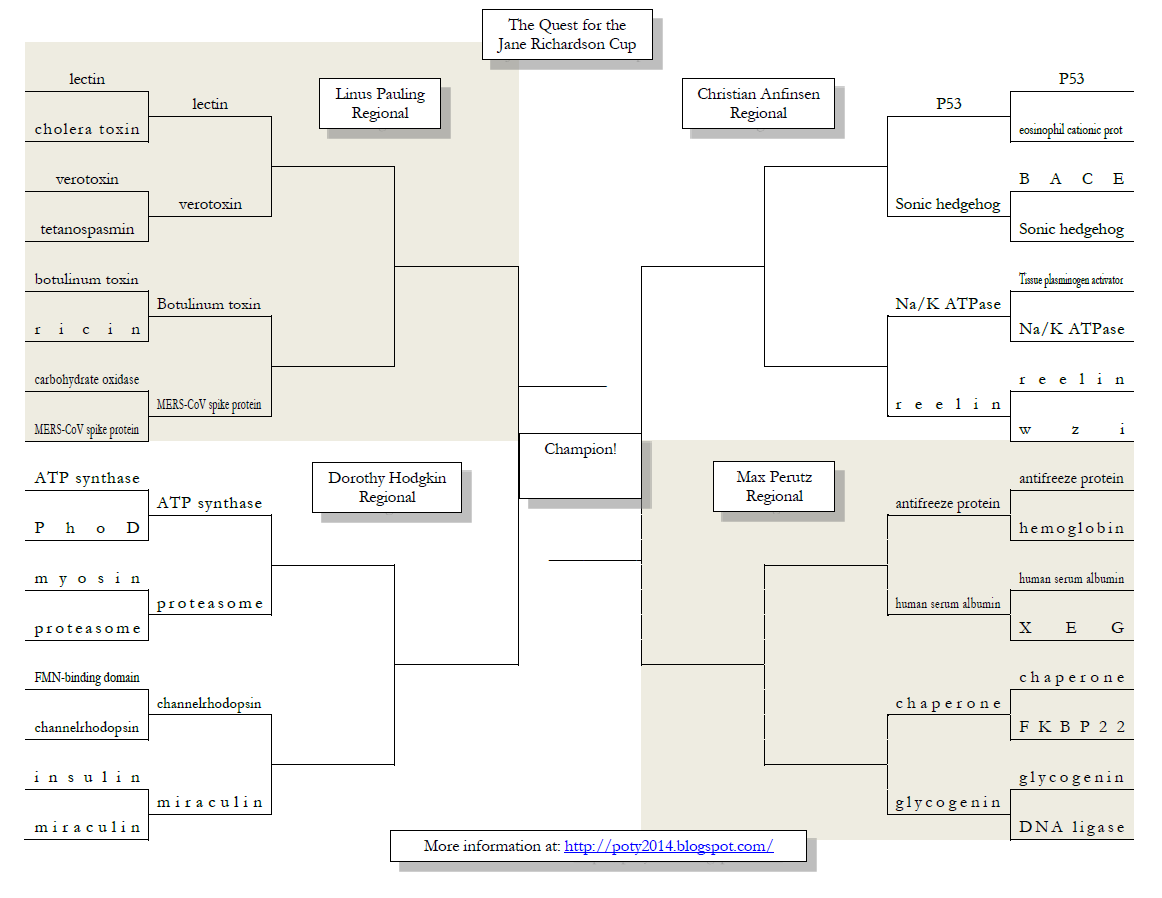Thursday, May 15, 2014
Tuesday, May 13, 2014
Friday, May 9, 2014
Final Four
The Final Four is set! Who will be the champion of 2014?
Voting ends at noon on Tuesday.
Final Four:
Wednesday, May 7, 2014
Elite 8
It's time for the regional finals! Which proteins will make the Final Four?
Voting ends at noon on Friday. Contact arnoys_at_calvin_dot_edu if you'd like to participate in the voting.
Linus Pauling Regional:
Dorothy
Crowfoot Hodgkin Regional:
Christian
Anfinsen Regional:
Max Perutz
Regional:
Monday, May 5, 2014
Sweet 16
After a tough first round, many very good proteins have been left behind. Such is the nature of a single knockout tournament.
Here are the matchups for the Sweet 16. Voting ends at noon on Wednesday. Contact arnoys_at_calvin_dot_edu if you'd like to participate in the voting.
Here are the matchups for the Sweet 16. Voting ends at noon on Wednesday. Contact arnoys_at_calvin_dot_edu if you'd like to participate in the voting.
Linus Pauling Regional:
Dorothy
Crowfoot Hodgkin Regional:
Christian
Anfinsen Regional:
Max Perutz
Regional:
Friday, May 2, 2014
clickable matchups for the first round


Anand Divakaran, author of the winning Protein of the Year 2013 entry, holds the Jane Richardson Cup. This was the breakthrough year for nitrogenase after it had been eliminated in the Final Four in 2012.
If you are interested in participating in the voting, please submit your request to arnoys_at_calvin_dot_edu.
The Quest for
the Jane Richardson Cup
Linus Pauling Regional:
lectin vs. cholera toxin
botulinum toxin vs. ricin
Dorothy Crowfoot
Hodgkin Regional:
ATP synthase vs. Pho D
myosin vs. proteasome
Christian
Anfinsen Regional:
BACE vs. sonic hedgehog
Max Perutz
Regional:
glycogenin
vs. DNA ligase
Thursday, May 1, 2014
stories of the bracket
Jane Richardson was trained as a philosopher and a physicist but soon turned to studies of protein structures. She developed a means of representing α-helices and β-sheets in tertiary structures that is now the standard for protein structures, and she has continued her work as a pioneer in protein structure study and representation. She is now a member of the National Academy of Sciences, among other awards. In honor of her beautiful illustrations that have become the standard for understanding structure/function relationships, the prize for Protein of the Year is named “The Jane Richardson Cup.”
suggested links:
Linus Pauling won a Nobel Prize in Chemistry in part for predicting the structures of α-helices and β-sheets in proteins. He won a second Nobel Prize in Peace for his work on nuclear disarmament and the Partial Test Ban Treaty which limited above ground nuclear testing . He was close to a third prize for the structure of DNA, but Watson and Crick beat him to it.
suggested links:
Dorothy Crowfoot Hodgkin was a pioneer in x-ray crystallography, and many of the early protein crystallographers credit her work as a forerunner for theirs. She solved the first structures of vitamin B12 and insulin, among other things, and she won a Nobel Prize in Chemistry for this work in 1964.
suggested links:
Christian Anfinsen won a Nobel Prize for his elegant experiments demonstrating that the information necessary for ribonuclease folding was contained in its amino acid sequence. We know that this holds for other proteins, though sixty years later we still do a poor job of predicting a protein’s structure from its sequence.
suggested links:
Max Perutz is another giant in protein x-ray crystallography, having solved the initial structures of both oxy- and deoxyhemoglobin and proposing the Perutz mechanism by which hemoglobin switches between the R state and T state to bind and release oxygen. Along with John Kendrew, he received the Nobel Prize for his work in studying the structures of globular proteins.
suggested links:
Proteins in Red Shirts
What will the first round look like? A few of our proteins will need opponents from outside of our class.
I give you Proteins in Red Shirts.
If you don't know the reference, check out What's in a name.
Subscribe to:
Comments (Atom)






